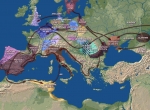Migration Period
Migration Period, fifth century is regarded as the historical period of population shifts, occasionally (e.g., in French and Russian) referred to as “period of great migrations”. Nevertheless, this breakthrough time in the history of Europe started earlier, when the →Huns advanced on Eastern Europe in 375. While this was happening, Roman Period structures across most of Barbarian Europe →Barbaricum , its central regions in particular, were still intact. And, the Migration Period is definitely not confined to the 5th c. given that the last of the great European migrations, the Langobard migration →Langobards from Pannonia to Italy, took place only in 568.
The migrations of the barbarian peoples (map 1.) →Germanic Tribes and Asian nomads, the →Huns and the Alans - and the pressure they exerted on the provinces of the Roman Empire, precipitated the breakdown of the defensive and economic system of the Western Roman Empire. Ravaged by incessant incursions, its provinces, especially the Danubian ones, could not sustain their economic status. The first to be abandoned, in 275, during the reign of Aurelian, was Dacia; in 410 all of Pannonia and the eastern reaches of Noricum were surrendered to the →Germanic Tribes . Even earlier, in 259/260, after the incursion by the Alemanni the lands between the Middle Rhine and Upper Danube (agri decumates) were lost to them. Thus, the process was not a rapid one but it did intensify after the invasion of the →Huns . Some historians have argued that the role of barbarian invasions as the main cause of the fall of the Western Roman Empire should not be overestimated still, the accounts given by classical authors abound in reports of invasions during which the Romans lost their estates and had to accept a sharp drop in their social status. There is no question that barbarian invasions were a key reason for the fall of the Western Empire as they brought in their wake hunger and destruction.
During the 5th c. from the region north of the Danube and west of the Rhine we have a record of very rich burials and hoards, attributed to barbarians, full of gold objects and coins, evidence of tribute payments received by the →Germanic Tribes and →Huns in return for their services as Foederati allies in the Roman army and, presumably, also for holding back from invading the Roman territory. Also relevant was the steady barbarization of the Roman army in which the highest ranks came to be occupied by Germanic chiefs. A classic example is Stilicho, half Vandal, half Roman, father-in-law to Emperor Honorius, murdered in 408, the last high commander of both Roman armies – eastern and western.
The barbarians →Barbaricum who had broken through the frontiers into the Empire soon became Romanized, adopting the language, burial customs and dress. This process is most apparent in the Kingdom of Toledo of the →Visigoths and in the Vandal state →Vandals in Africa. The generation which migrated to the new lands retained the costume traditional for their people but successive generations gradually succumbed to the Roman customs. The lingua franca of the barbarians was vulgar Latin, in a way that simplified English is spoken all over the world today.
5th century archaeology has developed a system of chronology based on finds from the Middle and the Lower Danube. The Migration period is marked as phase D, according to the periodization of Otto Tischler from late 19th c. Phase D was later divided by J. Tejral and V. Bierbrauer into several stages. The system adopted here is by J. Tejral because it corresponds best with the situation on the territory of Poland during the Migration Period and uses the following stages:
D1 – 360/370-400/410
D2 – 380/400-440/450 (Untersiebenbrunn horizon →Sösdala-Untersiebenbrunn Style)
D2/D3 – 430/440-470/480
D3 – 450-480/490
D3/E (Early Merovingian stage) – 470-500/510
MM
Literature: O. Tischler, Ostpreussische Gräberfelder III, Königsberg 1879; J. Tejral, Zur Chronologie der frühen Völkerwanderungszeit im mittleren Donauraum, Archaeologia Austriaca 72, 1988, p. 223-304; V. Bierbrauer, Das Frauengrab von Castelbolognese in der Romagna (Italien). Zur chronologischen, ethnischen und historischen Auswertbarkeit des ostgermanischen Fundstoffs des 5. Jahrhunderts in Südosteuropa und Italien, Jahrbuch des Römisch-Germanischen Zentralmuseums Mainz 38, 1995, p. 541-592; J. Tejral, Neue Aspekte der frühvölkerwanderungszeitlichen Chronologie im Mitteldonauraum [in:] J. Tejral, H. Friesinger, M. Kazanski (eds.), Neue Beiträge zur Erforschung der Spätantike im mittleren Donauraum, Spisy Arheologického Ústavu AV ČR Brno 8, Brno 1997, p. 321-392; M. Wilczyński, Germanie w sluźbie zachodniorzymskiej w V w. n. e. Studium historyczno-prosopograficzne, Kraków 2001; W. Pohl, Die Völkerwanderung. Eroberung und Integration, Stuttgart 2002; P. Heather, The Fall of Roman Empire: A New History, London 2005; P. Heather, Upadek csarstwa rzymskiego, Poznań 2006; P. Heather, Imperia i barbarzyńcy. Migracje i narodziny Europy, Poznań 2010; M. Mączyńska, Światło z popiołu. Wędrwówki ludów w Europie w IV i V w., Warszawa 2013.
-
 full resolution
full resolution
Map 1. Migrations of barbarian peoples in late 4th and during 5th century (developed by M. Mączyńska and M. Levada).


